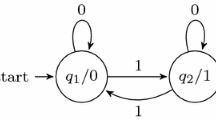Abstract
Computations by spiking neurons are performed using the timing of action potentials. We investigate the computational power of a simple model for such a spiking neuron in the Boolean domain by comparing it with traditional neuron models such as threshold gates (or McCulloch–Pitts neurons) and sigma-pi units (or polynomial threshold gates). In particular, we estimate the number of gates required to simulate a spiking neuron by a disjunction of threshold gates and we establish tight bounds for this threshold number. Furthermore, we analyze the degree of the polynomials that a sigma-pi unit must use for the simulation of a spiking neuron. We show that this degree cannot be bounded by any fixed value. Our results give evidence that the use of continuous time as a computational resource endows single-cell models with substantially larger computational capabilities.
Similar content being viewed by others
References
V. Chvátal and P.L. Hammer, Aggregation of inequalities in integer programming, in: Studies in Integer Programming, eds. P.L. Hammer, E.L. Johnson, B.H. Korte and G.L. Nemhauser, Annals of Discrete Mathematics, Vol. 1 (North-Holland, Amsterdam, 1977) pp. 145–162.
W. Gerstner, Time structure of the activity in neural network models, Phys. Rev. E 51 (1995) 738–758.
P.L. Hammer, T. Ibaraki and U.N. Peled, Threshold numbers and threshold completions, in: Studies on Graphs and Discrete Programming, ed. P. Hansen, Annals of Discrete Mathematics, Vol. 11 (Mathematics Studies, Vol. 59) (North-Holland, Amsterdam, 1981) pp. 125–145.
R.G. Jeroslow, On defining sets of vertices of the hypercube by linear inequalities, Discrete Math. 11 (1975) 119–124.
W. Maass, Lower bounds for the computational power of networks of spiking neurons, Neural Computation 8 (1996) 1–40.
W. Maass, Fast sigmoidal networks via spiking neurons, Neural Computation 9 (1997) 279–304.
W. Maass, Networks of spiking neurons: The third generation of neural network models, Neural Networks 10 (1997) 1659–1671.
W. Maass, On the relevance of time in neural computation and learning, in: Proceedings of the 8th International Workshop on Algorithmic Learning Theory ALT' 97, eds. M. Li and A. Maruoka, Lecture Notes in Artificial Intelligence, Vol. 1316 (Springer, Berlin, 1997) pp. 364–384.
W. Maass and M. Schmitt, On the complexity of learning for a spiking neuron, in: Proceedings of the 10th Annual Conference on Computational Learning Theory COLT' 97 (ACM Press, New York, 1997) pp. 54–61.
W. Maass and M. Schmitt, On the complexity of learning for spiking neurons with temporal coding, Electronic Colloquium on Computational Complexity, ECCC TR97-049 (1997); available via WWW at URL http://www.eccc.uni-trier.de/eccc/.
M.L. Minsky and S.A. Papert, Perceptrons: An Introduction to Computational Geometry, expanded edition (MIT Press, Cambridge, MA, 1988).
S. Muroga, Threshold Logic and Its Applications (Wiley, New York, 1971).
A. Murray and L. Tarassenko, Analogue Neural VLSI: A Pulse Stream Approach (Chapman and Hall, London, 1994).
F. Rieke, D. Warland, W. Bialek and R. de Ruyter van Steveninck, SPIKES: Exploring the Neural Code (MIT Press, Cambridge, MA, 1996).
W. Softky and C. Koch, Single-cell models, in: The Handbook of Brain Theory and Neural Networks, ed. M.A. Arbib (MIT Press, Cambridge, MA, 1995) pp. 879–884.
C. Wang and A.C. Williams, The threshold order of a Boolean function, Discrete Appl. Math. 31 (1991) 51–69.
Yu. A. Zuev, Asymptotics of the logarithm of the number of threshold functions of the algebra of logic, Soviet Math. Dokl. 39 (1989) 512–513.
Yu. A. Zuev and L.I. Lipkin, Estimating the efficiency of threshold representations of Boolean functions, Kibernetika (Kiev) 6 (1988) 29–37. English translation in: Cybernetics 24 (1988) 713– 723.
Author information
Authors and Affiliations
Rights and permissions
About this article
Cite this article
Schmitt, M. On computing Boolean functions by a spiking neuron. Annals of Mathematics and Artificial Intelligence 24, 181–191 (1998). https://doi.org/10.1023/A:1018953300185
Issue Date:
DOI: https://doi.org/10.1023/A:1018953300185




